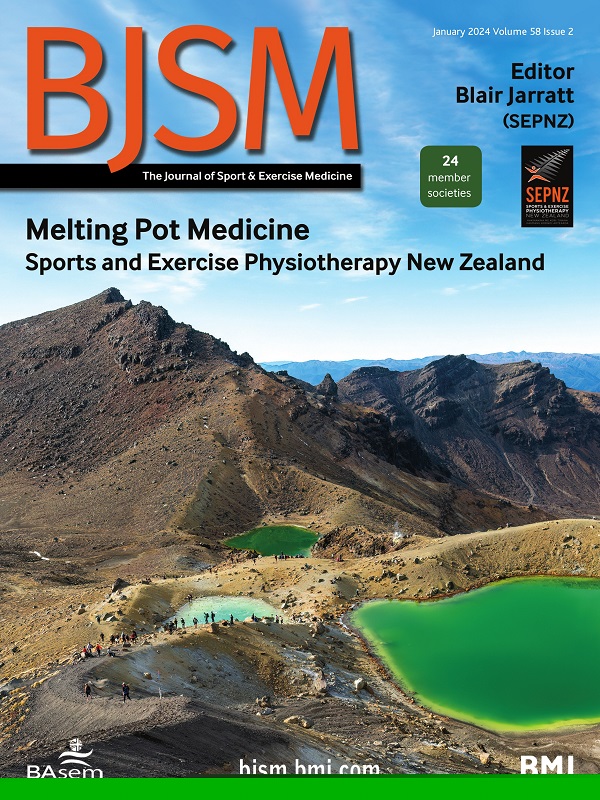Sustained benefits of blood flow restriction therapy in knee osteoarthritis rehabilitation: 1-year follow-up of a randomised controlled trial
IF 16.2
1区 医学
Q1 SPORT SCIENCES
引用次数: 0
Abstract
Objective Knee osteoarthritis (KOA) is a leading cause of global disability and remains challenging to treat. Blood flow restriction (BFR) shows promising rehabilitation outcomes, but its lasting effects in KOA are lacking. This study aimed to determine the 1-year outcomes of a BFR-enhanced exercise therapy programme in patients with KOA. Methods This study included 120 patients (33 male, 87 female) from a previously published randomised controlled trial comparing 12 weeks of traditional exercise therapy with and without BFR, performed twice per week. For the current analysis, patients were reassessed at 1 year. The primary outcome was the Knee Osteoarthritis Outcome Score (KOOS) questionnaire, with secondary outcomes including muscle strength and a functional test battery. Data on knee joint injections and activity levels were also reviewed at 1-year follow-up. Analyses consisted of linear mixed models with Dunn-Sidak corrections for multiple comparisons, with an intention to treat approach ([NCT04996680][1]). Results Clinically meaningful improvements at 1 year were found in favour of the BFR group for KOOS subscales ‘pain’ (mean difference (MD): 15.1 points ES=0.79, p=0.0039), ‘symptoms’ (MD: 10.5 points, ES=0.51, p=0.0074), ‘activities of daily living’ (ADL) (MD: 11.3 points, ES=0.54, p=0.0054) and ‘quality of life’ (QoL) (MD: 14.7 points, ES=0.61, p=0.0032) compared with exercise therapy without BFR. The BFR group outperformed the non-BFR group for the functional tests, and muscle strength remained significantly higher at 1 year in the BFR group (ES=0.48, p=0.0010) as opposed to no BFR. The BFR group was more active by 1.5 hours/week (p=0.036) and had 3.6 times lower odds of receiving knee injections compared with the non-BFR group. Conclusion A 12-week BFR-enhanced exercise therapy programme provides benefits for pain, symptoms, ADL, QoL, muscle strength and functional capacity at 1-year follow-up while reducing the need for knee injections by 63.4% compared with traditional exercise therapy alone. Data are available upon reasonable request. Data are available upon reasonable request. Requests for data sharing from appropriate researchers and entities will be considered on a case-by-case basis. Interested parties should contact EJ. [1]: /lookup/external-ref?link_type=CLINTRIALGOV&access_num=NCT04996680&atom=%2Fbjsports%2Fearly%2F2025%2F08%2F21%2Fbjsports-2024-109524.atom限制血流治疗在膝关节骨关节炎康复中的持续益处:1年随机对照试验随访
目的膝关节骨关节炎(KOA)是全球致残的主要原因,治疗仍然具有挑战性。血流限制(BFR)显示出良好的康复效果,但其在KOA中的持久效果尚缺乏。本研究旨在确定bfr增强运动治疗方案对KOA患者的1年预后。方法本研究纳入了120例患者(33名男性,87名女性),这些患者来自之前发表的一项随机对照试验,比较了12周的传统运动疗法,每周进行两次,有和没有BFR。对于目前的分析,患者在1年后重新评估。主要结局是膝关节骨关节炎结局评分(oos)问卷,次要结局包括肌肉力量和功能测试组。在1年的随访中也回顾了膝关节注射和活动水平的数据。分析包括多重比较的线性混合模型和Dunn-Sidak校正,意图处理方法([NCT04996680][1])。结果与不进行BFR的运动治疗相比,一年后,在KOOS亚量表“疼痛”(平均差值(MD): 15.1分,ES=0.79, p=0.0039)、“症状”(MD: 10.5分,ES=0.51, p=0.0074)、“日常生活活动”(ADL) (MD: 11.3分,ES=0.54, p=0.0054)和“生活质量”(QoL) (MD: 14.7分,ES=0.61, p=0.0032)方面,BFR组均有临床意义的改善。在功能测试中,BFR组的表现优于非BFR组,与无BFR组相比,BFR组的肌肉力量在1年后仍显着高于无BFR组(ES=0.48, p=0.0010)。与非BFR组相比,BFR组活动量多1.5小时/周(p=0.036),接受膝关节注射的几率低3.6倍。结论:与传统运动疗法相比,为期12周的bfr增强运动疗法方案在1年随访时对疼痛、症状、ADL、QoL、肌肉力量和功能能力都有好处,同时减少了63.4%的膝关节注射需求。如有合理要求,可提供资料。如有合理要求,可提供资料。来自适当研究人员和实体的数据共享请求将逐案考虑。有兴趣人士请联络EJ。[1]: /查找/ external-ref ? link_type = CLINTRIALGOV&access_num = NCT04996680&atom = % 2 fbjsports % 2恐惧% 2 f2025 % 2 f08 % 2 f21 % 2 fbjsports - 2024 - 109524. -原子
本文章由计算机程序翻译,如有差异,请以英文原文为准。
求助全文
约1分钟内获得全文
求助全文
来源期刊
CiteScore
27.10
自引率
4.90%
发文量
217
审稿时长
3-8 weeks
期刊介绍:
The British Journal of Sports Medicine (BJSM) is a dynamic platform that presents groundbreaking research, thought-provoking reviews, and meaningful discussions on sport and exercise medicine. Our focus encompasses various clinically-relevant aspects such as physiotherapy, physical therapy, and rehabilitation. With an aim to foster innovation, education, and knowledge translation, we strive to bridge the gap between research and practical implementation in the field. Our multi-media approach, including web, print, video, and audio resources, along with our active presence on social media, connects a global community of healthcare professionals dedicated to treating active individuals.

 求助内容:
求助内容: 应助结果提醒方式:
应助结果提醒方式:


